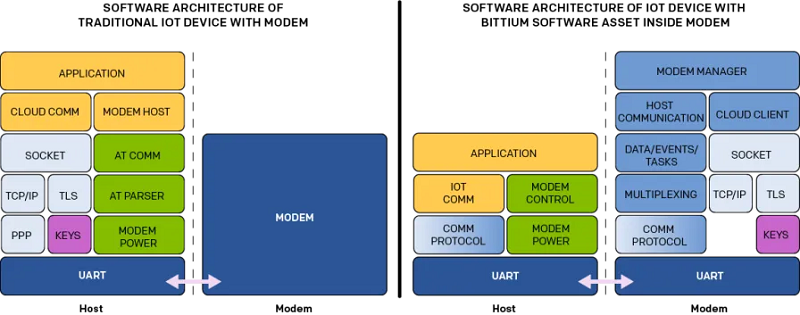Upgrading IoT Devices with Cellular Connectivity – Part 3

Author: Manu Kemppainen, Bittium Fellow
In part 1 of this blog post series, we described the principle of how to take connected medical devices, or any other IoT device, to the next level – by integrating cellular connectivity directly into the device. In part 2, we went through the real life challenges involved in the design of a device with cellular connectivity and how we solved those.
In this third and last part of the series we take a closer look at the re-usable software solution we developed and implemented, and how we can apply it to any IoT device to make product development more cost-efficient.
usable software solution we developed and how we can apply it to any IoT device.
Minimized Need for Hardware Changes and Ease of Use
When we started the development work our goal was to make a re-usable and future-proof solution for connected devices, which would make product development more straightforward and cost-efficient, while at the same time simplifying the system and the use of the device.
As a result, we can now offer a software solution, Bittium Cellular IoT Solution, that offers the capability to run software code inside the modem module of a connected device. The modem module is then responsible for all the communication to the cloud. This approach minimizes the requirements towards the host hardware and offloads cloud processing and communication stack software from the host system.
There are multiple benefits that the direct connection to cloud offers. Data coming from the device can be processed in cloud/edge, which can for example change data protocol to be compatible with different cloud systems. There is no need to update device software that is already deployed on the field, you can just update cloud/edge software instead. And by collecting all data directly to the cloud, data processing is more efficient and new services and even business models can be created.
The elimination of a gateway device between the IoT device and the cloud simplifies the system and lowers overall cost. End users benefit from true mobility and ease of use as there is no need to worry about pairing Bluetooth devices and whether Wi-Fi connection is on or off.

Re-Usable Software Modules
The software solution has a modular structure that enables straightforward portability to cellular modem modules that support the application software running inside the module. Modules with this support are available widely, for example from Nordic, U-Blox, Quectel, and Telit.
The solution has three re-usable software modules
- Host Communication Module – Architectural adaptation layer to the host system. Enables isolated adaptation to the host system hardware and software minimizing the changes for the system.
- Modem Manager Module – Modem activity orchestrator with actual modem hardware and firmware adaptation. Modem manager controls the actual modem, modem state, LTE recovery and governs the activities of the Host Communication Module and Cloud Client Module.
- Cloud Client Module – Communication module to the cloud/edge. Cloud Client Module adapts the data, event, task, and control communication from the host system to the target cloud infrastructure and selected protocols. Cloud Client Module uses modem’s trusted environment for the communication security.
Traditional vs New Software Architecture

Applicable to Any IoT Product
In this blog post series, we presented a case where the solution was integrated with a medical device. In fact, the solution is applicable to practically any IoT device, whether it is upgrading its old connectivity or developing a completely new product with latest 4G/5G connectivity. Custom-built device with latest technologies usually results in the optimal product (size, price, operating time) with lowest operating costs.
Bittium´s R&D expertise can help with the entire product development project, from your idea to a commercial product.
Can we help with your product development project? Find out more about our Engineering Services for Healthcare & Medical, and Engineering Services for Industrial IoT and contact us!
Manu Kemppainen, Bittium Fellow
Manu Kemppainen has over 30 years of experience in embedded software design and device development. He works as a Fellow at Bittium and has been with the company since 1999.
